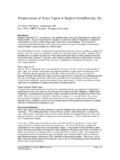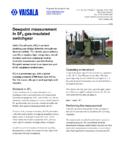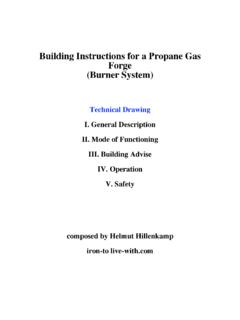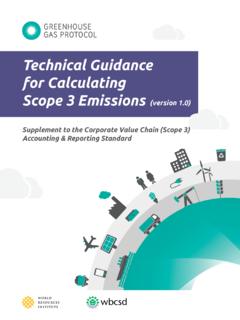Transcription of What I have learned about SF gas testing….in …
1 What I have learned about SF6 gas practical explanation Over the past few years, testing of SF6 gas quality has become increasingly important and with the EPA in USA, setting guidelines for loss reporting and taxes on SF6 bottles and possible fines to utilities, it is now more important than ever. Let alone the increased consciousness to improve a utilities grid uptime by ensuring proper insulation characteristics of SF6 gas in HV electrical apparatus. The above need plus the variations in gas suppliers quality process and measuring process, it is now important to understand SF6 gas quality measurement techniques and test equipment available.
2 A few mysteries and inconsistencies exist and hopefully this may answer some. IN USA, the 3 most important measurements in order of popularity and history are: 1. Moisture (aka dew point, or humidity) most conveniently expressed in ppmv. (but also can be in deg C or deg C with ref to 20 deg C) 2. Purity expressed in % of SF6 in the gas sample tested 3. Decomposition products, usually measure by SO2 detection Typical values for above are: 1. Moisture: <50 ppmv for new gas, <150ppmv for gas in use in a breaker or GIS and >150ppmv is wet gas that needed drying or re-conditioning and >400ppmv is definitely dangerous to use. 2. Purity: <97% should be replaced, >97% and to 100% is good useable gas, to 100% is new good gas.
3 3. Decomposition products: In most tests, it is 0 ppm, and up to 100 ppm is not such problem, over 500 ppm is a problem that definitely needs attention, and it indicates acidic compounds are present in the breaker (white powder which can erode most components and certainly be dangerous to humans hands, eyes and lungs exposed while working on an open breaker chamber) NOTE: These numbers for 1 to 3 are just typical and utility and breaker manufacturers and CIGRE standards may be different values. Thus there is a need to measure these values to ensure safe operation of circuit breakers and GIS, plus safety to workers present. And now to learn about measurement technology: 1.
4 Moisture: There are two basic sensor technologies here, a. alumina oxide electronic detection and b. chilled mirror physical property detection 2. Purity: There are two basic technologies here, a. speed of sound comparison of SF6 gas vs air and b. chilled mirror condensation detection 3. Decomposition products: Unfortunately the only detection sensor here in SF6 combo test instruments is an electrochemical sensor that has a limited operational life of 18 to 24 months, once first activated. And all test set manufacturers use this same sensor, at present. There is also a Draeger tube technology and uses visual detection of multiple gases including SO2, but not SF6.
5 It is quite subjective though and its use is decreasing in the industry. So let s dig deeper into the technologies and uncover some mysteries: 1. Moisture: A. The alumina oxide sensor is made by depositing a very thin layer of aluminum on an electronic substrate and oxidizing it and then coating it for durability. The exact construction and deposition of AL varies by sensor manufacturer. As moisture molecules are passed over this device it changes the electric current flow thru the substrate and such change can be calibrated to read as ppmv of moisture. It is usually calibrated for pressure of 0 psig as there is no resistance to air flow.
6 The problem is these sensors drift and need to be checked or calibrated very often, sometimes even daily. And over time the moisture that stays on the sensor becomes sticky, almost like honey and distorts the readings and reads higher, and more often the readings drift to the low number due to continual oxidation and degradation of the sensor, such that low values of ppmv are displayed but are not really the right moisture numbers. One can observe this by allowing the gas to pass for a longer period of time, say longer than 10 minutes, and the number will drift downward. I suppose the very process they use to oxidize the aluminum in the first place never really stops and the sensors continue to oxidize with use and cause the readings to drift downward.
7 Almost all brands of moisture meters use this sensor, brands such as Co, Di, De, Em, Wi, Ph, Pa etc. (names are not completed for business courtesy reasons). Such accuracies are typically 2 deg C or 3 deg C in lower reading ranges. Plus the unknown drift factor. Regular calibration is very important for this type of instrument. B. The chilled mirror technology was originally the highly accurate lab only detection technique. RH Systems model 973-SF6 uniquely uses this technology in a rugged, automatic field instrument. This unit allows gas to pass over a small rugged mirror and uses a known regulated internal pressure and a precision RTD temperature detection and creates a reading trigger by optically detecting a fog on the mirror.
8 The fog appearance is the dew point . So this is effectively a physical property measurement and as such is not prone to drifting. Any contamination on the mirror is detected and noted to the operator as clean mirror . Very easy to do. If readings are suspicious there is a built-in self-check mode call ice test that allows the operator to easily verify temperature measurement circuitry and sensors. Such technology allows measurement accuracy of deg C or better which relates to about 6% of a ppmv reading. Regular formal calibration is not as important for this type of instrument, although a check out by a qualified lab every two years would be a good practice.
9 2. Purity: A. The speed of sound is a common technique used and involves calculations and assumptions of pressure (affected by barometric pressure). This technique also relies on assumptions of the contaminating gas composition. In other words, this instrument is typically calibrated assuming that air is the contaminating gas. If the contaminating gas is something other (say nitrogen, oxygen, carbon monoxide, SO2, etc. for example), then the speed of sound measurements will produce inaccurate purity results. B. The chilled mirror technique again uses physical property measurements where the temperature of the same mirror is brought down to where the fog condenses into liquid, indicating the point of the gas is really SF6.
10 SF6 liquefies at a lower temperature than water and higher than other gases possibly present. So this optical detection, again, combined with a repeatable comparison table accurately results in % of SF6 displayed. 3. Decomposition products: There is not much more to say about the SO2 electro-chemical sensor as an exact numerical value is not so important here, as it is more a question of a little presence indicating a possible trend or a lot of presence indicating re-furb work is required and there has been a lot of SF6 decomposition. Purity (%) and Moisture (ppmv) are the two more important parameters to have accurate numbers. Also experienced noses (rotten egg smell) can tell if present or not in breakers where there has been many high current interruptions.








